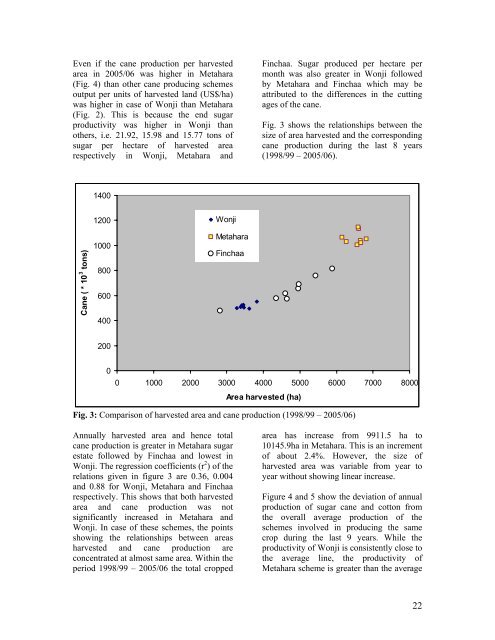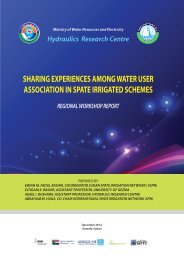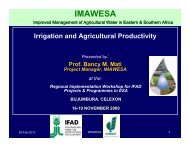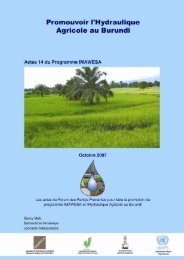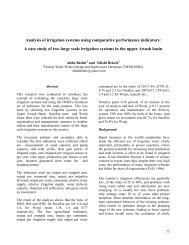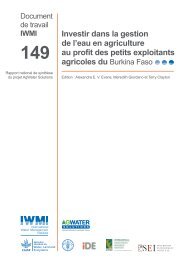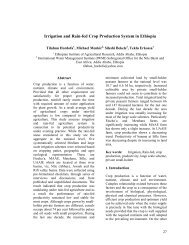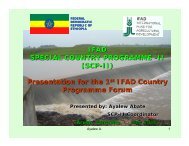Comparison of irrigation performance based on management and ...
Comparison of irrigation performance based on management and ...
Comparison of irrigation performance based on management and ...
Create successful ePaper yourself
Turn your PDF publications into a flip-book with our unique Google optimized e-Paper software.
Even if the cane producti<strong>on</strong> per harvested<br />
area in 2005/06 was higher in Metahara<br />
(Fig. 4) than other cane producing schemes<br />
output per units <str<strong>on</strong>g>of</str<strong>on</strong>g> harvested l<strong>and</strong> (US$/ha)<br />
was higher in case <str<strong>on</strong>g>of</str<strong>on</strong>g> W<strong>on</strong>ji than Metahara<br />
(Fig. 2). This is because the end sugar<br />
productivity was higher in W<strong>on</strong>ji than<br />
others, i.e. 21.92, 15.98 <strong>and</strong> 15.77 t<strong>on</strong>s <str<strong>on</strong>g>of</str<strong>on</strong>g><br />
sugar per hectare <str<strong>on</strong>g>of</str<strong>on</strong>g> harvested area<br />
respectively in W<strong>on</strong>ji, Metahara <strong>and</strong><br />
Finchaa. Sugar produced per hectare per<br />
m<strong>on</strong>th was also greater in W<strong>on</strong>ji followed<br />
by Metahara <strong>and</strong> Finchaa which may be<br />
attributed to the differences in the cutting<br />
ages <str<strong>on</strong>g>of</str<strong>on</strong>g> the cane.<br />
Fig. 3 shows the relati<strong>on</strong>ships between the<br />
size <str<strong>on</strong>g>of</str<strong>on</strong>g> area harvested <strong>and</strong> the corresp<strong>on</strong>ding<br />
cane producti<strong>on</strong> during the last 8 years<br />
(1998/99 – 2005/06).<br />
1400<br />
Cane ( * 10 3 t<strong>on</strong>s)<br />
1200<br />
1000<br />
800<br />
600<br />
400<br />
W<strong>on</strong>ji<br />
Metahara<br />
Finchaa<br />
200<br />
0<br />
0 1000 2000 3000 4000 5000 6000 7000 8000<br />
Area harvested (ha)<br />
Fig. 3: <str<strong>on</strong>g>Comparis<strong>on</strong></str<strong>on</strong>g> <str<strong>on</strong>g>of</str<strong>on</strong>g> harvested area <strong>and</strong> cane producti<strong>on</strong> (1998/99 – 2005/06)<br />
Annually harvested area <strong>and</strong> hence total<br />
cane producti<strong>on</strong> is greater in Metahara sugar<br />
estate followed by Finchaa <strong>and</strong> lowest in<br />
W<strong>on</strong>ji. The regressi<strong>on</strong> coefficients (r 2 ) <str<strong>on</strong>g>of</str<strong>on</strong>g> the<br />
relati<strong>on</strong>s given in figure 3 are 0.36, 0.004<br />
<strong>and</strong> 0.88 for W<strong>on</strong>ji, Metahara <strong>and</strong> Finchaa<br />
respectively. This shows that both harvested<br />
area <strong>and</strong> cane producti<strong>on</strong> was not<br />
significantly increased in Metahara <strong>and</strong><br />
W<strong>on</strong>ji. In case <str<strong>on</strong>g>of</str<strong>on</strong>g> these schemes, the points<br />
showing the relati<strong>on</strong>ships between areas<br />
harvested <strong>and</strong> cane producti<strong>on</strong> are<br />
c<strong>on</strong>centrated at almost same area. Within the<br />
period 1998/99 – 2005/06 the total cropped<br />
area has increase from 9911.5 ha to<br />
10145.9ha in Metahara. This is an increment<br />
<str<strong>on</strong>g>of</str<strong>on</strong>g> about 2.4%. However, the size <str<strong>on</strong>g>of</str<strong>on</strong>g><br />
harvested area was variable from year to<br />
year without showing linear increase.<br />
Figure 4 <strong>and</strong> 5 show the deviati<strong>on</strong> <str<strong>on</strong>g>of</str<strong>on</strong>g> annual<br />
producti<strong>on</strong> <str<strong>on</strong>g>of</str<strong>on</strong>g> sugar cane <strong>and</strong> cott<strong>on</strong> from<br />
the overall average producti<strong>on</strong> <str<strong>on</strong>g>of</str<strong>on</strong>g> the<br />
schemes involved in producing the same<br />
crop during the last 9 years. While the<br />
productivity <str<strong>on</strong>g>of</str<strong>on</strong>g> W<strong>on</strong>ji is c<strong>on</strong>sistently close to<br />
the average line, the productivity <str<strong>on</strong>g>of</str<strong>on</strong>g><br />
Metahara scheme is greater than the average<br />
22


